Over my nearly four decades working in interior design, I’ve had the pleasure of assisting clients in choosing artists and artworks that will enrich the rooms I create–and to enhance their experience of living in them. But for those just setting out to form an art collection, this can be an intimidating task. The omnipresent question remains: Where do we begin?
At the beginning of my career, it was a bit more involved. But in the twenty-first-century information age, all that’s required is curiosity and an internet connection. Here are 10 suggestions for artists you should know, and examples of their work.
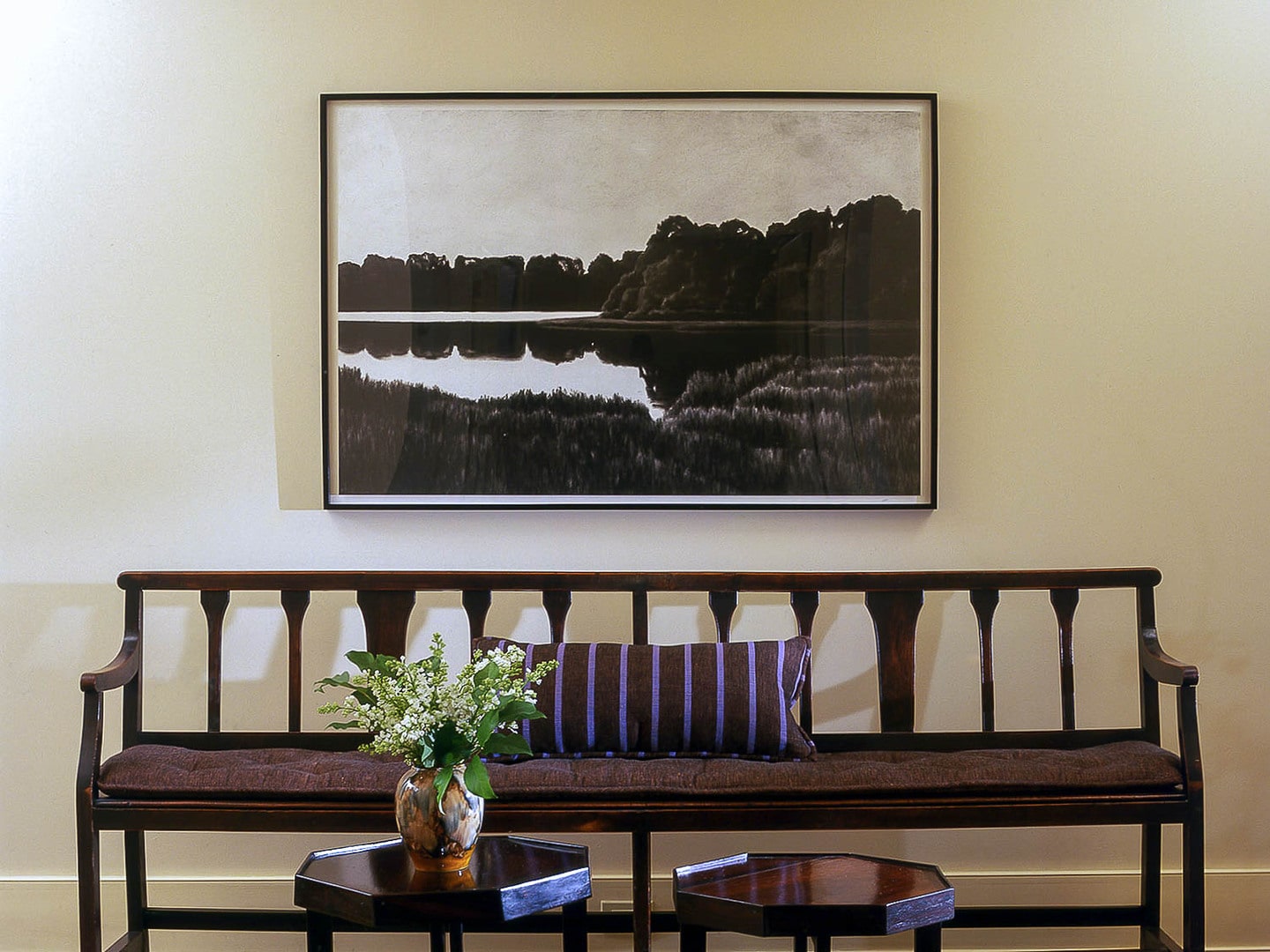
A long carved-wood trestle bench beckons to guests in this tableau replete with Chinese Chippendale tables. A work by April Gornick hangs above.
April Gornik
“April Gornik is an American painter whose atmospheric landscape paintings focus heavily on cloud formations. “Now I make my landscapes so that I can be in them,” the artist remarked. “That’s why I alter them [landscapes], that’s why I make them somewhat artificial because I want to take possession of them.” Born on April 20, 1953, in Cleveland, OH, she studied at the Nova Scotia College of Art and Design in Halifax, Canada, receiving her BFA there in 1976.
Strongly referencing American Luminists like John Fredrick Kensett, the artist’s work has gained significant attention and critical acclaim since her first solo exhibition. Gornik lives and works in Long Island, NY with her husband, the painter Eric Fischl. Her works are presently held in the collections of institutions such as The Museum of Modern Art in New York, the Museum of Fine Arts Houston, and the Smithsonian American Art Museum in Washington, D.C, among others.”
To investigate further, April Gornik is represented by the Miles McEnery Gallery in New York.
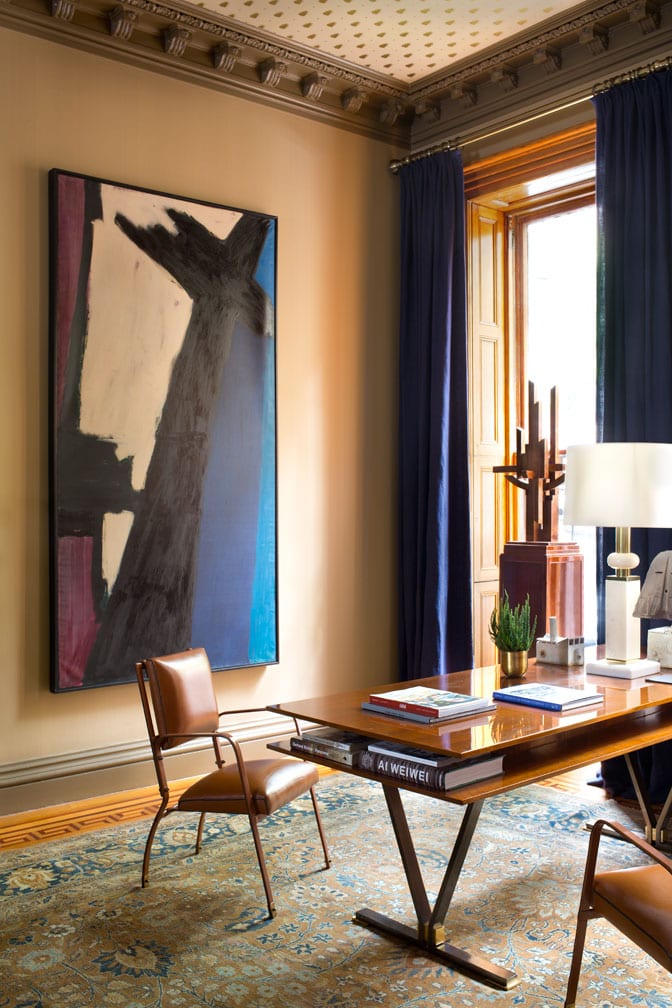
The 1959 painting by Abstract Expressionist painter Judith Godwin, entitled ‘Black Cross’, pairs beautifully with the striking Jules Leleu modernist table-desk and the pair of vintage Jacques Adnet leather-wrapped chairs. The rusted steel sculpture by Marino di Teana sits proudly on a mahogany pedestal in the window.
Judith Godwin (1930-2021)
Like many other women artists of her generation, Judith Godwin received less attention in the mid-and late twentieth century from the press and public than her male counterparts. Godwin explained the bias behind this imbalance, recalling that at the time, “the men simply said, ‘Women can’t paint.’” However, the steadfast creativity and accomplishment of Godwin and other women of her time have become increasingly acknowledged and given overdue consideration. Among the recent efforts at such restitution was the 2016 groundbreaking exhibition, Women of Abstract Expressionism, held at the Denver Art Museum.”
I met the remarkable artist Judith Godwin (1930-2021) on her 89th birthday at the opening of ‘An Act of Freedom’ at Berry Campbell. When we designed the Grand Parlor in the Brooklyn Heights Showhouse we featured “Black Cross”, 1959 a brawny and outstanding early work by the spirited painter.
Godwin’s work is represented in many museum collections including MoMA, The Metropolitan Museum of Art, and The Art Institute of Chicago. To investigate further, Judith Godwin’s work is represented by Berry Campbell in New York.

The 1947 painting, “Fugue,” by Abstract Expressionist James Brooks, rivets our attention. Poised on the custom coffee table is an ancient work of Pre-Columbian art, a Colima Carinate Vessel, between 300 B.C. and 300 A.D., from Douglas Dawson Gallery.
James Brooks (1906-1992)
James Brooks was an Abstract Expressionist who was deeply ‘in the mix’ with the Greenwich Village arts community, including Jackson Pollack and Lee Krasner. When Pollack and Krasner moved to Long Island, Brooks moved into their apartment. He married artist Charlotte Park in 1947, the same year he painted the painting in the image above. And then, in 1949, he and Park moved to East Hampton to live and work near their artist friends on the East End of Long Island.
James Brooks‘ artwork is in many significant art museums including the Museum of Modern Art, Whitney Museum, Art Institute of Chicago, The Metropolitan Museum of Art, Fogg Art Museum Harvard University, the Smithsonian American Art Museum, and many, many more.
To investigate further, James Brooks’ work is represented by Van Doren Waxter in New York.

This dining room also acts as a study that can be used for occasional entertaining, centered upon the Empire round table the clients brought from Colorado. The chairs are from a 1930s ocean liner. A portiere marks the separation from the bedroom. The large-scale photograph is by Edward Burtynsky.
Edward Burtynsky
Much of the photographic oeuvre of Edward Burtynsky participates in dialogue and criticism about how we treat our planet, and the humans that share it. He has turned his lens on the terrible beauty of industrial interventions in nature such as mining, quarrying, manufacturing, shipping, the production of oil, and recycling.
Here, his focus is on the Three Gorges Dam project in China where approximately 1.13 million people were ‘relocated’ and their livelihoods were challenged when fertile agricultural lands and important cultural/historic sites were submerged under a vast reservoir.
Burtynsky’s work is both beautiful in its composition and execution, while simultaneously frightening as he exposes some of the large-scale violence against nature in contemporary society. To investigate further, Edward Burtynsky is represented by Howard Greenberg Gallery in New York.

In lieu of the ubiquitous television, a metal sculpture by Richard Filopowski sits on the limestone fireplace mantle in this grand West Village home.
Richard Filipowski (1923-2008)
Richard Filipowski was originally a student, then a faculty member of the New Bauhaus where he taught alongside Walter Gropius and Marcel Breuer from 1946-to 1950. He would subsequently go on to hold positions at the Institute of Design in Chicago, Harvard School of Design, and Massachusetts Institute of Technology (MIT) where he taught for 36 years.
Filipowski’s works are in numerous museum collections including The Philadelphia Museum, The Museum of Fine Art in Boston, the Addison Gallery of American Art, and the Walter Gropius House Museum in Lincoln, Massachusetts.
While Filipowski was a prolific artist, creating hundreds of drawings, paintings, sculptures, he was deeply private about his personal creative endeavors. Referring to them as “art of the psyche”, he believed that they were purely a process of self-expression and exploration, a personal endeavor not need not be subject to criticism of commercialization. This impulse towards privacy, coupled with his lifelong dedication to educating others, are contributing factors to his having achieved less notoriety than some of his Bauhaus peers.
To investigate further, Richard Filipowski’s work is represented by Hostler Burrows in New York.

A 1955 painting by Joan Mitchell in a gilded frame hangs above the mantelpiece in a high-rise duplex apartment realized by Glenn Gissler Design.
Joan Mitchell (1925 –1992)
Joan Mitchell was an American artist whose primary medium was oil paint on canvas, although she also created drawings and prints. “Over the course of nearly five decades, she established a singular visual vocabulary rooted in gestural abstraction.”
Although she lived in France for much of her life she is considered a member of the ‘New York School’ of artists in the 1950s, often referred to as the abstract expressionist movement.
While most of the women artists of the time were marginalized, Mitchell was one of her era’s few female painters to gain critical and public acclaim. Her paintings, drawings, and editioned prints can be seen in major museums and collections around the world, and are now highly coveted and command enormous prices. Here’s an excellent overview of Mitchell and her work.
To investigate further, Joan Mitchell’s work is represented by David Zwirner in New York.

A large, lively, and colorful canvas by Larry Poons hangs above the sofa, flanked by Ombre Italian Lamps from the 1950s in acidic yellow and greens that add an element of surprise to the room’s palette.
Larry Poons
An American abstract painter, Larry Poons originally intended on becoming a musician and composer, studied music and musical composition at the New England Conservatory of Music from 1955 to 1957. However, after seeing a Barnett Newman exhibition in 1959, he gave up his work in musical composition and enrolled at the School of the Museum of Fine Arts, Boston, and studied at the Art Students League of New York.
Associated with Op Art, Hard-edge painting, Color Field painting, Lyrical Abstraction, and Abstract Expressionism, Poons has challenged critical expectations throughout his career, transitioning through several distinct phases of work. According to New York Times critic Roberta Smith, “Since emerging in the 1960s, Mr. Poons has shown a strong preference for allover fields of pulsing color, even if his means of achieving them have varied enormously.”
To investigate further, Larry Poons is represented by Yares Art in New York.
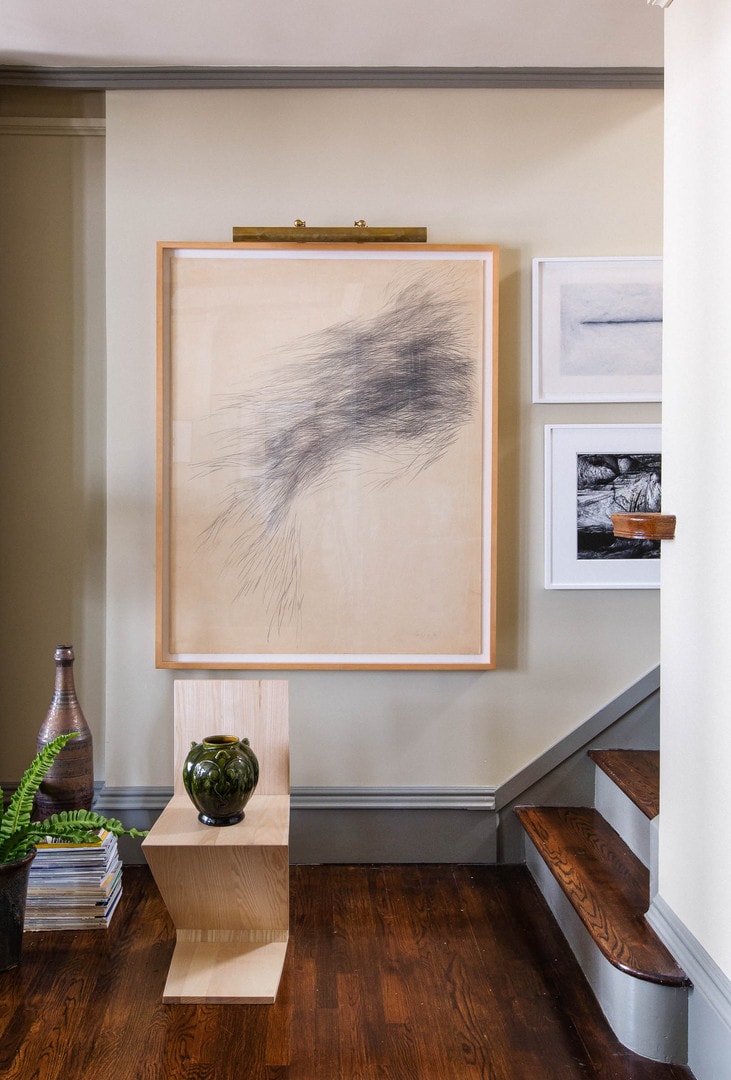
A crisp classic of early 20th-century design, De Stijl designer Gerrit Rietveld’s Zig-zag chair is paired with a framed 1958 drawing that dominates the vignette by American artist Sonia Gechtoff.
Sonia Gechtoff (1926-2018)
Before moving to New York City in the late 1950s, Sonia Gechtoff spent her formative years immersed with the San Francisco Beat Generation deeply influencing her development as an artist. She gained national recognition in 1954 when her work was exhibited in the Guggenheim Museum’s “Younger American Painters” show alongside Willem de Kooning, Franz Kline, Robert Motherwell, and Jackson Pollock.
I offered this incredible late 1950s drawing to a couple of clients who declined; I wouldn’t let this one get away, so I bought it for myself and she has been with me for a dozen years. The drawing and I are more or less the same age and it serves as an inspiration to remain in motion!
To investigate further, Sonia Gechtoff’s work is represented by David Richard Gallery in New York.
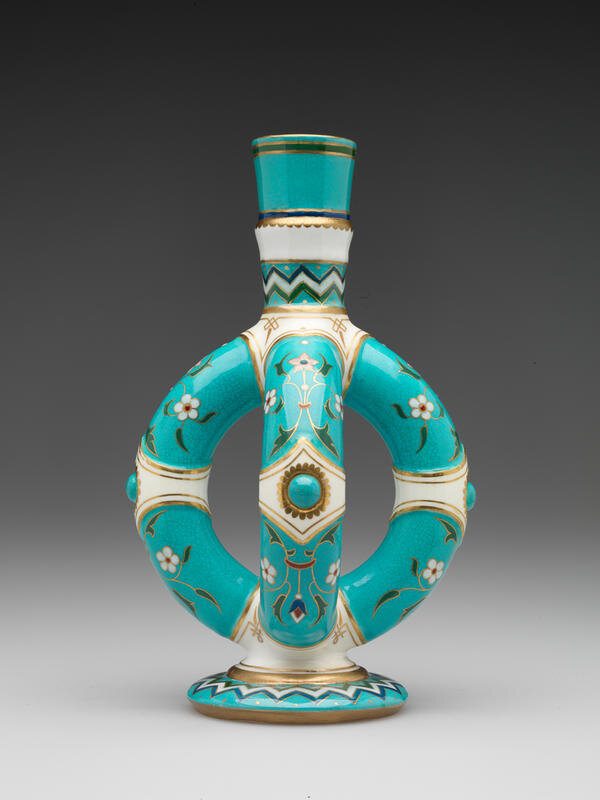
2013; Dr. Christopher Dresser, Vase, c. 1875, Minton Pottery Factory, English manufacturer, 1793-present. Porcelain with enamels and gilding. 20.3 x 12.7 x 12.7 cm (8 x 5 x 5 inches).
Christopher Dresser (1834-1904)
Nineteenth-century British industrial designer Christopher Dresser was (and remains) a hugely influential character in my work. A pivotal figure in the Aesthetic Movement and a major contributor to the allied Anglo-Japanese or Modern Style (referred to as British Art Nouveau), Dresser was a prolific multi-disciplinarian, having produced carpets, ceramics, furniture, glass, graphics, metalwork, including silver and electroplate, and textiles printed and woven.
I delight in placing pieces by Dresser in my interior design projects, but as an alum of The Rhode Island School of Design, I revel in donating his works to that institution’s formidable museum. My dear friend the art historian Lisa Zeiger wrote about my history of bequeathing objects to the museum in this enlightening post. Since 1984 I’ve
As an aside: There are always wonderful pieces by Dresser up for auction online–most notably on eBay and 1st Dibs. And frankly considering Dresser’s relative importance in the canon of Western industrial design, there are always bargains to be found which makes adding his work to your collection affordable.
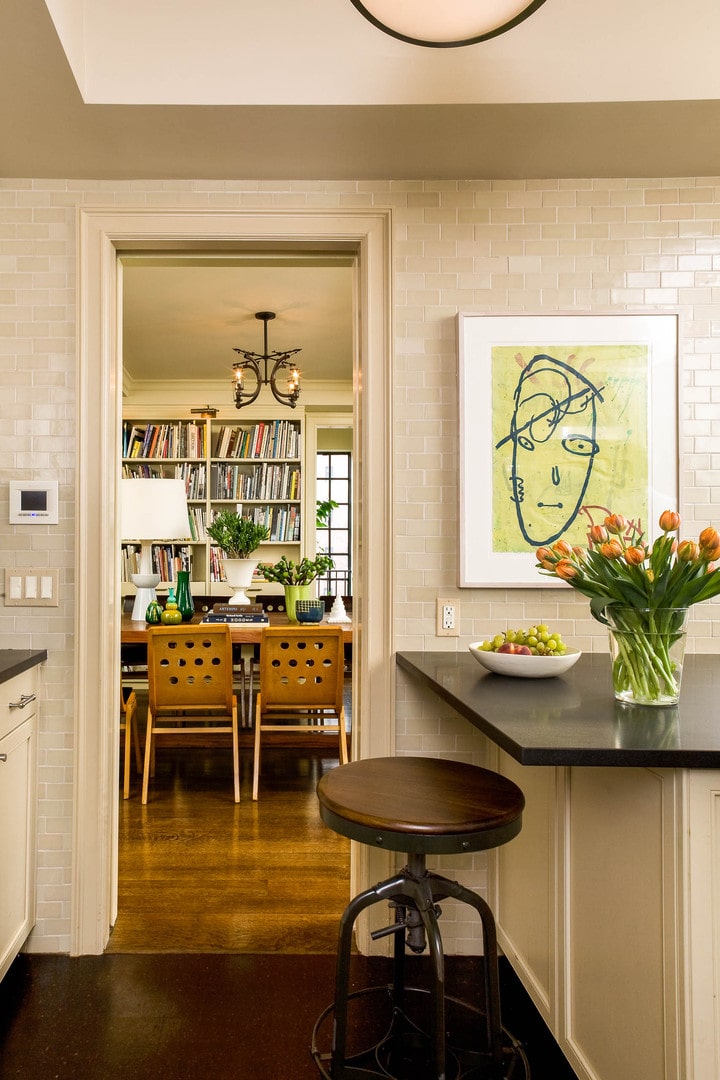
Art pervades the kitchen in this Gissler-designed lower 5th Avenue apartment, with a large drawing by Donald Baechler. Just beyond are mid-century Austrian chairs with pierced slats designed in the 1950s for Vienna’s city hall.
Donald Baechler
“An American artist who figured prominently in the Neo-Expressionist and Pop Art movements during the 1980s, Donald Baechler Incorporates child-like depictions of iconic subjects, such as flowers, birds, and ice cream cones. The works convey a feeling of memory without becoming an illustration. Culled from a huge archive of images the artist has collected, his prints, paintings, and sculptures focus more on formal attributes than narrative. “I’m drawn to silhouettes because of their emblematic rather than their illustrational quality,” he reflected. “I see them as shapes, allowing an image to become an abstraction and for pure painting to take place.”
Born on November 22, 1956, in Hartford, CT, he grew up in a Quaker family who nourished his early artistic talent. He went on to study at the Maryland Institute College of Art in Baltimore from 1974 to 1977 and continued his education at New York’s Cooper Union. In New York, he befriended Tony Shafrazi, who in 1979 founded a downtown gallery that reflected his interest in artwork inspired by graffiti art. In this milieu, Baechler found himself amidst figures such as Keith Haring, Jean-Michel Basquiat, and Kenny Scharf. He continues to live and works in New York, NY. Today, his works are held in the collections of the Goetz Collection in Munich, The Museum of Modern Art in New York, and the Philadelphia Museum of Art, among others.”
To investigate further, Donald Baechler is represented by Cheim Read in New York.
